Kaixin Li
AdamMeme: Adaptively Probe the Reasoning Capacity of Multimodal Large Language Models on Harmfulness
Jul 02, 2025Abstract:The proliferation of multimodal memes in the social media era demands that multimodal Large Language Models (mLLMs) effectively understand meme harmfulness. Existing benchmarks for assessing mLLMs on harmful meme understanding rely on accuracy-based, model-agnostic evaluations using static datasets. These benchmarks are limited in their ability to provide up-to-date and thorough assessments, as online memes evolve dynamically. To address this, we propose AdamMeme, a flexible, agent-based evaluation framework that adaptively probes the reasoning capabilities of mLLMs in deciphering meme harmfulness. Through multi-agent collaboration, AdamMeme provides comprehensive evaluations by iteratively updating the meme data with challenging samples, thereby exposing specific limitations in how mLLMs interpret harmfulness. Extensive experiments show that our framework systematically reveals the varying performance of different target mLLMs, offering in-depth, fine-grained analyses of model-specific weaknesses. Our code is available at https://github.com/Lbotirx/AdamMeme.
Data Whisperer: Efficient Data Selection for Task-Specific LLM Fine-Tuning via Few-Shot In-Context Learning
May 18, 2025Abstract:Fine-tuning large language models (LLMs) on task-specific data is essential for their effective deployment. As dataset sizes grow, efficiently selecting optimal subsets for training becomes crucial to balancing performance and computational costs. Traditional data selection methods often require fine-tuning a scoring model on the target dataset, which is time-consuming and resource-intensive, or rely on heuristics that fail to fully leverage the model's predictive capabilities. To address these challenges, we propose Data Whisperer, an efficient, training-free, attention-based method that leverages few-shot in-context learning with the model to be fine-tuned. Comprehensive evaluations were conducted on both raw and synthetic datasets across diverse tasks and models. Notably, Data Whisperer achieves superior performance compared to the full GSM8K dataset on the Llama-3-8B-Instruct model, using just 10% of the data, and outperforms existing methods with a 3.1-point improvement and a 7.4$\times$ speedup.
Enhancing Visual Grounding for GUI Agents via Self-Evolutionary Reinforcement Learning
May 18, 2025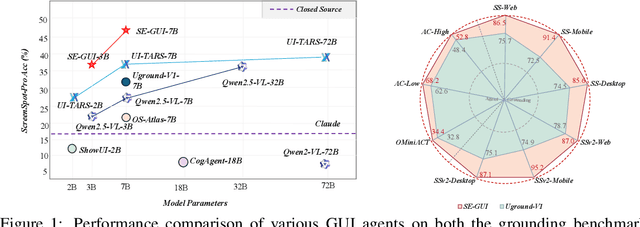
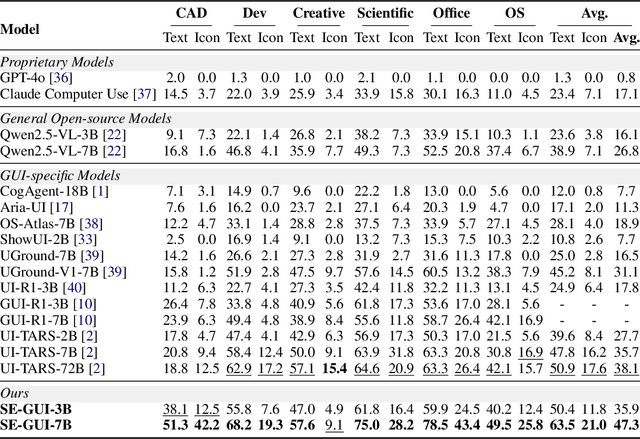
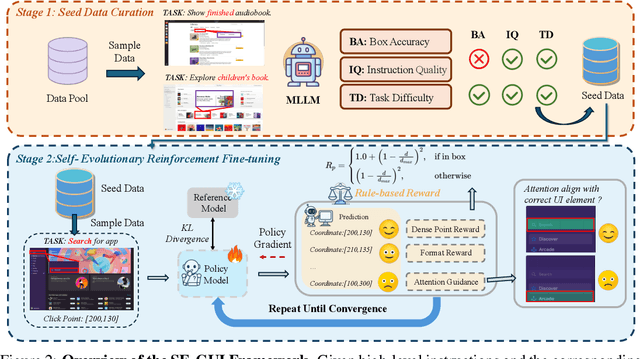

Abstract:Graphical User Interface (GUI) agents have made substantial strides in understanding and executing user instructions across diverse platforms. Yet, grounding these instructions to precise interface elements remains challenging, especially in complex, high-resolution, professional environments. Traditional supervised finetuning (SFT) methods often require large volumes of diverse data and exhibit weak generalization. To overcome these limitations, we introduce a reinforcement learning (RL) based framework that incorporates three core strategies: (1) seed data curation to ensure high quality training samples, (2) a dense policy gradient that provides continuous feedback based on prediction accuracy, and (3) a self evolutionary reinforcement finetuning mechanism that iteratively refines the model using attention maps. With only 3k training samples, our 7B-parameter model achieves state-of-the-art results among similarly sized models on three grounding benchmarks. Notably, it attains 47.3\% accuracy on the ScreenSpot-Pro dataset, outperforming much larger models, such as UI-TARS-72B, by a margin of 24.2\%. These findings underscore the effectiveness of RL-based approaches in enhancing GUI agent performance, particularly in high-resolution, complex environments.
MCTS-Judge: Test-Time Scaling in LLM-as-a-Judge for Code Correctness Evaluation
Feb 18, 2025Abstract:The LLM-as-a-Judge paradigm shows promise for evaluating generative content but lacks reliability in reasoning-intensive scenarios, such as programming. Inspired by recent advances in reasoning models and shifts in scaling laws, we pioneer bringing test-time computation into LLM-as-a-Judge, proposing MCTS-Judge, a resource-efficient, System-2 thinking framework for code correctness evaluation. MCTS-Judge leverages Monte Carlo Tree Search (MCTS) to decompose problems into simpler, multi-perspective evaluations. Through a node-selection strategy that combines self-assessment based on historical actions in the current trajectory and the Upper Confidence Bound for Trees based on prior rollouts, MCTS-Judge balances global optimization and refinement of the current trajectory. We further designed a high-precision, unit-test-level reward mechanism to encourage the Large Language Model (LLM) to perform line-by-line analysis. Extensive experiments on three benchmarks and five LLMs demonstrate the effectiveness of MCTS-Judge, which improves the base model's accuracy from 41% to 80%, surpassing the o1-series models with 3x fewer tokens. Further evaluations validate the superiority of its reasoning trajectory in logic, analytics, thoroughness, and overall quality, while revealing the test-time scaling law of the LLM-as-a-Judge paradigm.
Robi Butler: Remote Multimodal Interactions with Household Robot Assistant
Sep 30, 2024Abstract:In this paper, we introduce Robi Butler, a novel household robotic system that enables multimodal interactions with remote users. Building on the advanced communication interfaces, Robi Butler allows users to monitor the robot's status, send text or voice instructions, and select target objects by hand pointing. At the core of our system is a high-level behavior module, powered by Large Language Models (LLMs), that interprets multimodal instructions to generate action plans. These plans are composed of a set of open vocabulary primitives supported by Vision Language Models (VLMs) that handle both text and pointing queries. The integration of the above components allows Robi Butler to ground remote multimodal instructions in the real-world home environment in a zero-shot manner. We demonstrate the effectiveness and efficiency of this system using a variety of daily household tasks that involve remote users giving multimodal instructions. Additionally, we conducted a user study to analyze how multimodal interactions affect efficiency and user experience during remote human-robot interaction and discuss the potential improvements.
Not All Samples Should Be Utilized Equally: Towards Understanding and Improving Dataset Distillation
Aug 22, 2024Abstract:Dataset Distillation (DD) aims to synthesize a small dataset capable of performing comparably to the original dataset. Despite the success of numerous DD methods, theoretical exploration of this area remains unaddressed. In this paper, we take an initial step towards understanding various matching-based DD methods from the perspective of sample difficulty. We begin by empirically examining sample difficulty, measured by gradient norm, and observe that different matching-based methods roughly correspond to specific difficulty tendencies. We then extend the neural scaling laws of data pruning to DD to theoretically explain these matching-based methods. Our findings suggest that prioritizing the synthesis of easier samples from the original dataset can enhance the quality of distilled datasets, especially in low IPC (image-per-class) settings. Based on our empirical observations and theoretical analysis, we introduce the Sample Difficulty Correction (SDC) approach, designed to predominantly generate easier samples to achieve higher dataset quality. Our SDC can be seamlessly integrated into existing methods as a plugin with minimal code adjustments. Experimental results demonstrate that adding SDC generates higher-quality distilled datasets across 7 distillation methods and 6 datasets.
Towards Better Text-to-Image Generation Alignment via Attention Modulation
Apr 22, 2024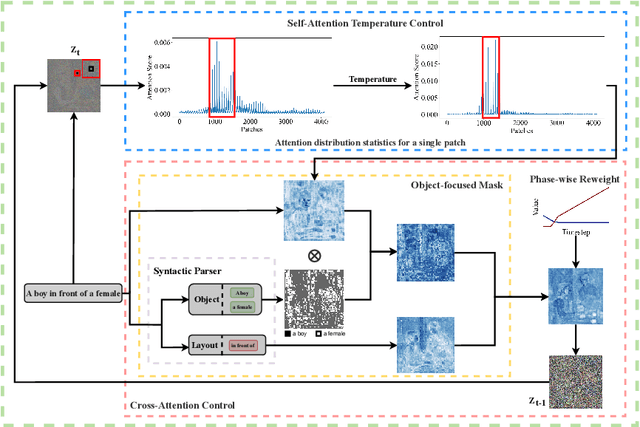

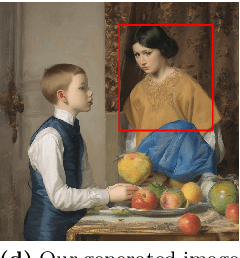

Abstract:In text-to-image generation tasks, the advancements of diffusion models have facilitated the fidelity of generated results. However, these models encounter challenges when processing text prompts containing multiple entities and attributes. The uneven distribution of attention results in the issues of entity leakage and attribute misalignment. Training from scratch to address this issue requires numerous labeled data and is resource-consuming. Motivated by this, we propose an attribution-focusing mechanism, a training-free phase-wise mechanism by modulation of attention for diffusion model. One of our core ideas is to guide the model to concentrate on the corresponding syntactic components of the prompt at distinct timesteps. To achieve this, we incorporate a temperature control mechanism within the early phases of the self-attention modules to mitigate entity leakage issues. An object-focused masking scheme and a phase-wise dynamic weight control mechanism are integrated into the cross-attention modules, enabling the model to discern the affiliation of semantic information between entities more effectively. The experimental results in various alignment scenarios demonstrate that our model attain better image-text alignment with minimal additional computational cost.
MMCode: Evaluating Multi-Modal Code Large Language Models with Visually Rich Programming Problems
Apr 15, 2024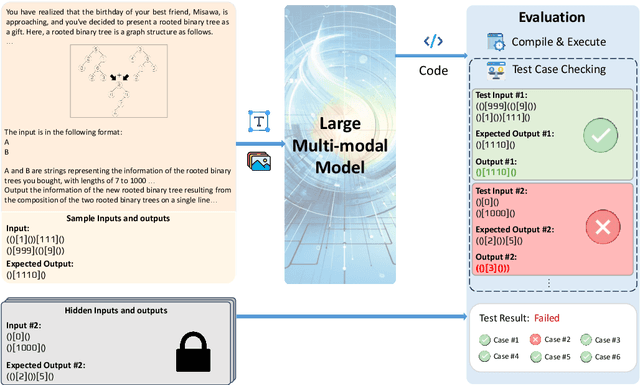
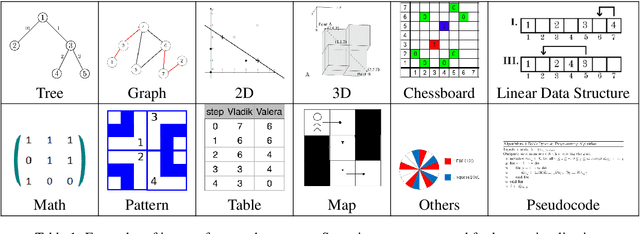
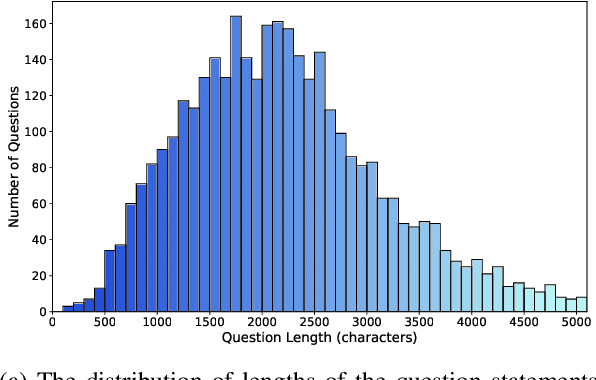
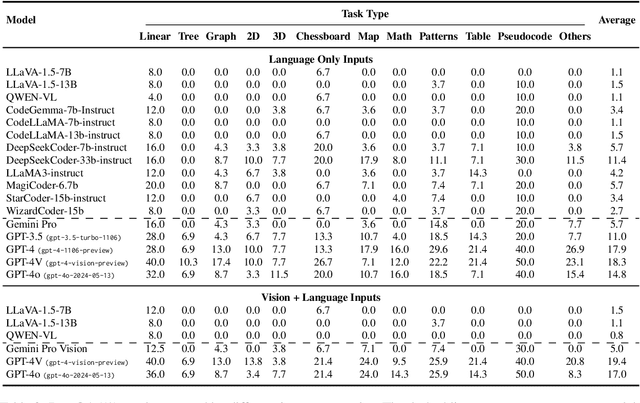
Abstract:Programming often involves converting detailed and complex specifications into code, a process during which developers typically utilize visual aids to more effectively convey concepts. While recent developments in Large Multimodal Models have demonstrated remarkable abilities in visual reasoning and mathematical tasks, there is little work on investigating whether these models can effectively interpret visual elements for code generation. To this end, we present MMCode, the first multi-modal coding dataset for evaluating algorithmic problem-solving skills in visually rich contexts. MMCode contains 3,548 questions and 6,620 images collected from real-world programming challenges harvested from 10 code competition websites, presenting significant challenges due to the extreme demand for reasoning abilities. Our experiment results show that current state-of-the-art models struggle to solve these problems. The results highlight the lack of powerful vision-code models, and we hope MMCode can serve as an inspiration for future works in this domain. The data and code are publicly available at https://github.com/happylkx/MMCode.
InstructCoder: Empowering Language Models for Code Editing
Oct 31, 2023Abstract:Code editing encompasses a variety of pragmatic tasks that developers deal with daily. Despite its relevance and practical usefulness, automatic code editing remains an underexplored area in the evolution of deep learning models, partly due to data scarcity. In this work, we explore the use of large language models (LLMs) to edit code based on user instructions, covering a broad range of implicit tasks such as comment insertion, code optimization, and code refactoring. To facilitate this, we introduce InstructCoder, the first dataset designed to adapt LLMs for general-purpose code editing, containing highdiversity code-editing tasks. It consists of over 114,000 instruction-input-output triplets and covers multiple distinct code editing scenarios. The dataset is systematically expanded through an iterative process that commences with code editing data sourced from GitHub commits as seed tasks. Seed and generated tasks are used subsequently to prompt ChatGPT for more task data. Our experiments demonstrate that open-source LLMs fine-tuned on InstructCoder can edit code correctly based on users' instructions most of the time, exhibiting unprecedented code-editing performance levels. Such results suggest that proficient instruction-finetuning can lead to significant amelioration in code editing abilities. The dataset and the source code are available at https://github.com/qishenghu/CodeInstruct.
Efficient Batch Homomorphic Encryption for Vertically Federated XGBoost
Dec 08, 2021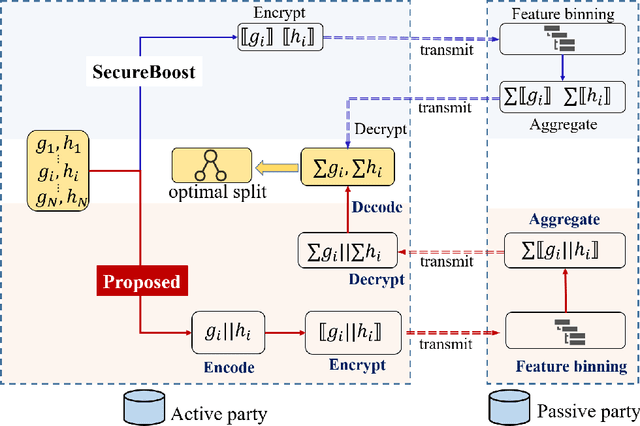
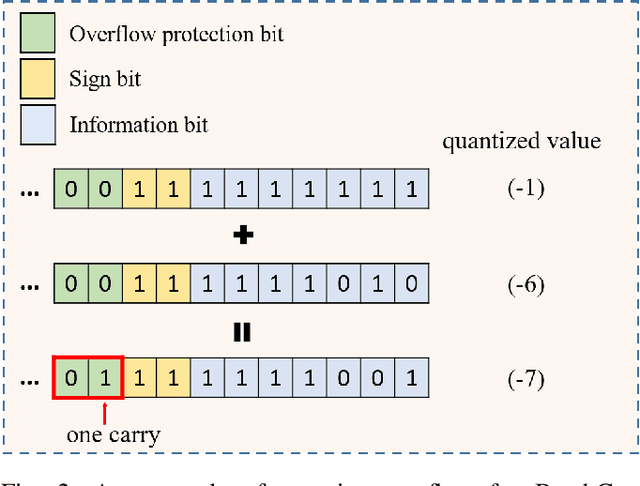
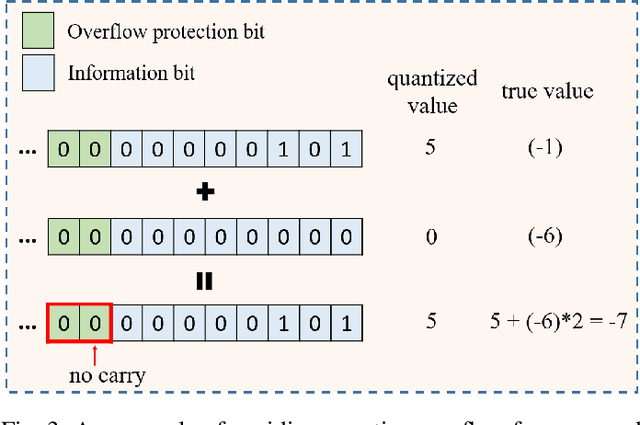
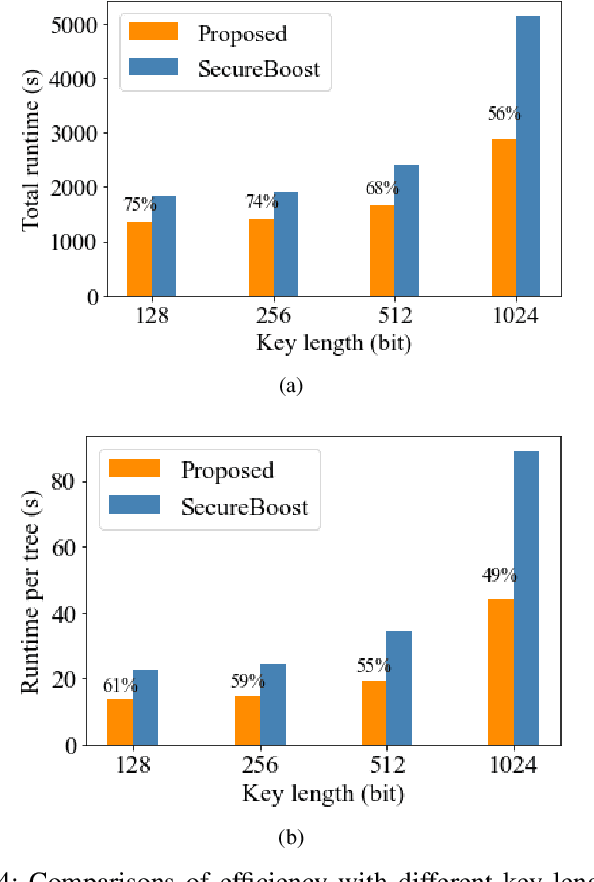
Abstract:More and more orgainizations and institutions make efforts on using external data to improve the performance of AI services. To address the data privacy and security concerns, federated learning has attracted increasing attention from both academia and industry to securely construct AI models across multiple isolated data providers. In this paper, we studied the efficiency problem of adapting widely used XGBoost model in real-world applications to vertical federated learning setting. State-of-the-art vertical federated XGBoost frameworks requires large number of encryption operations and ciphertext transmissions, which makes the model training much less efficient than training XGBoost models locally. To bridge this gap, we proposed a novel batch homomorphic encryption method to cut the cost of encryption-related computation and transmission in nearly half. This is achieved by encoding the first-order derivative and the second-order derivative into a single number for encryption, ciphertext transmission, and homomorphic addition operations. The sum of multiple first-order derivatives and second-order derivatives can be simultaneously decoded from the sum of encoded values. We are motivated by the batch idea in the work of BatchCrypt for horizontal federated learning, and design a novel batch method to address the limitations of allowing quite few number of negative numbers. The encode procedure of the proposed batch method consists of four steps, including shifting, truncating, quantizing and batching, while the decoding procedure consists of de-quantization and shifting back. The advantages of our method are demonstrated through theoretical analysis and extensive numerical experiments.
 Add to Chrome
Add to Chrome Add to Firefox
Add to Firefox Add to Edge
Add to Edge